Seventh Stage of Colonization and Settlement of Zarahemla
(East to the Sea by Zoramite Discenters - 90-74 BC)
by Don R. Hender
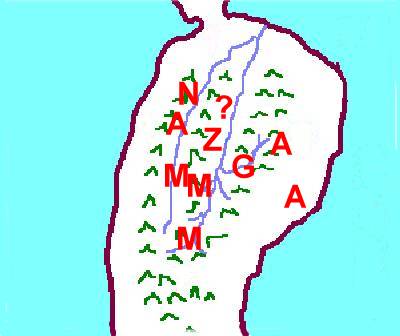 It is difficult to pin point just when the land of Antionum was first
inhabited. But it would seem to have been at first a gradual evolution which
perhaps began during the times of dissentions and divisions amongst the
people which seem to have began with Nehor (91-88 BC) and his presentations
of the concept of priestcraft taken from the courts of wicked King Noah,
thus there is this other dissenting group to consider, the people of Ammonihah
in the northwest and the people of Antionum or the Zoramites of the southeast.
Though each group located in their different regions for their own reasons,
the primary reason stated for the Zoramites removing themselves out to the
eastcoast, bordering the lands of the Lamanites on the south, is this very
reason, that they were dissenters from the Nephites. As such, Alma
was fearful that since they had broken with the Nephite mainstream, they
might next decide to join with the Lamanites against the Nephites. (Alma
30:59 & 31:1-4) Alma's corrective or preventative measure was to attempt to
convert them back to Christ and the Nephite true religion.
It is difficult to pin point just when the land of Antionum was first
inhabited. But it would seem to have been at first a gradual evolution which
perhaps began during the times of dissentions and divisions amongst the
people which seem to have began with Nehor (91-88 BC) and his presentations
of the concept of priestcraft taken from the courts of wicked King Noah,
thus there is this other dissenting group to consider, the people of Ammonihah
in the northwest and the people of Antionum or the Zoramites of the southeast.
Though each group located in their different regions for their own reasons,
the primary reason stated for the Zoramites removing themselves out to the
eastcoast, bordering the lands of the Lamanites on the south, is this very
reason, that they were dissenters from the Nephites. As such, Alma
was fearful that since they had broken with the Nephite mainstream, they
might next decide to join with the Lamanites against the Nephites. (Alma
30:59 & 31:1-4) Alma's corrective or preventative measure was to attempt to
convert them back to Christ and the Nephite true religion.
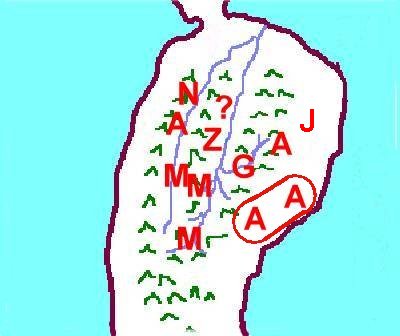
The land and city which the Zoramites established was called Antionum. It
was to the south of the land of Jershon, which Jershon we will talk about in
the coming Eighth Stage of colonization and settlement. But in truth there is
somewhat of a parallel development between the land of Antionum and Jershon.
When the land of Jershon was decided to be that land of the Anti-Nephi-Lehies
many Nephites were removed from there to make room for them in that land of
Jershon. And more specifically in conjunction with the land of Jershon
being that land set apart for the protection of the converted Lamanites,
it was also considered to thus be a land which needed protecting by the
armies of the Nephites. And thus armies of the Nephites were placed
between the land of Jershon and the land of the Lamanites, the land Nephi,
to protect the converted 'brethren Lamanites' from the unconverted hostile
Lamanites. And this would mean a build up of peoples associated with the
Nephite military which would create an influx of people to the land of
Antionum.
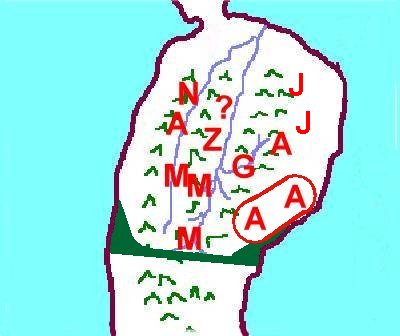 Now it is considered that land of Antionum and thus that of the 'Zoramites'
had been established before the sons of Mosiah II returned from their
Lamanite mission with the 'Anti-Nephi-Lehies', those converted Lamanites
associated with King Lamoni, who would be located in the land north of
Antionum, that is the land of Jershon, to live under the protection of the
Nephites, the Nephite armies placed between Jershon and the land of Nephi to
the south. And thus the land of Antionum would have been seen as just such
a buffer zone betwix the converted Lamanites, the Anti-Nephi-Lehies, and the
hostile Lamanites in the land of Nephi.
Now it is considered that land of Antionum and thus that of the 'Zoramites'
had been established before the sons of Mosiah II returned from their
Lamanite mission with the 'Anti-Nephi-Lehies', those converted Lamanites
associated with King Lamoni, who would be located in the land north of
Antionum, that is the land of Jershon, to live under the protection of the
Nephites, the Nephite armies placed between Jershon and the land of Nephi to
the south. And thus the land of Antionum would have been seen as just such
a buffer zone betwix the converted Lamanites, the Anti-Nephi-Lehies, and the
hostile Lamanites in the land of Nephi.
Now as such Alma had good reason to be concerned about maintaining the
Nephite allegiance of the people of Antionum to the cause of the Nephites
and for them not to be drawn away to the Lamanites. And thus Alma's organized
missionary efforts to the people and land of Antionum was born. During that
missionary effort, in the midst of the juncture in time of that effort, those
of Alma's mission came upon one of the chief complaints by the poor Zoramites,
which was that they had built their synagogues or 'chapels of worship' with
their own hands with the Rameumptom or holy stand in them only then to have
their priests not to allow them to worship in it them, for they had cast them
out because of their exceeding poverty (Alma 32:5). And here we have evidence
that there was more than one synagogue in the land of Antionum and therefore,
even though the 'city of Antionum' would be the chief city of the land, there
were other lesser towns about the land where other synagogues of worship had
also been built.
Now we are not given to understand that this was the descendants of Zoram
the servant of Laban. We are told instead that they called themselves
Zoramites because they were led by a man whose name was Zoram (Alma 30:59).
And we also find out in that verse that the land of Antionum would well
likely have been established prior to 76-74 B.C. and they would have had been
established in their land when Korihor came amongst them after having been
stuck dumb and had been run upon and trodden down until he was dead (74 B.C.).
Now all these developments were happening somewhat in parallel and thus though
we will place as stage 8, that time of the converted Lamanites being placed
in the land of Jershon, in truth much of stage 7 and stage 8 were occuring
in parallel at the same time.
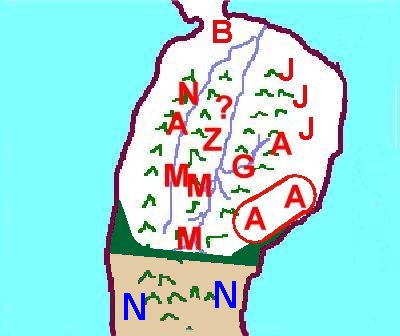 Now we seem to be able to associate the establishment of the settlement of
the land of Antionum to the single life time of either Zoram their leader
and/or the single lifetimes of the poor among the Zoramites who had so built
the chapels of worship of the Zoramites. It may or may not have been Zoram
who led them to the land of Antionum but he 'was' currently leading the
hearts of the people to bow down to dumb idols at that juncture when
Alma's missionary mission was to come into the land of Antionum (Alma 31:1).
Now the Lamanite King over all the land of Nephi, the father of King Lamoni,
had sent a proclamaion throughout the land of Nephi in support of the Nephite
missionaries having access to teach the gospel in the land. And it is at this
point that Mormon the compiler and abridge of the Nephite record does defined
and set out a verbal map of the national land of Zarahemla and that of the
national land of Nephi. He records that a narrow strip of land divded the two
nations from the east sea to the west sea with such idle wandering Lamanites
who were hunters and gatherers merging in along the shore line upon the east
and west sea coast of the national lands of Zarahemla which the provided map
at the right illustrates.
Now we seem to be able to associate the establishment of the settlement of
the land of Antionum to the single life time of either Zoram their leader
and/or the single lifetimes of the poor among the Zoramites who had so built
the chapels of worship of the Zoramites. It may or may not have been Zoram
who led them to the land of Antionum but he 'was' currently leading the
hearts of the people to bow down to dumb idols at that juncture when
Alma's missionary mission was to come into the land of Antionum (Alma 31:1).
Now the Lamanite King over all the land of Nephi, the father of King Lamoni,
had sent a proclamaion throughout the land of Nephi in support of the Nephite
missionaries having access to teach the gospel in the land. And it is at this
point that Mormon the compiler and abridge of the Nephite record does defined
and set out a verbal map of the national land of Zarahemla and that of the
national land of Nephi. He records that a narrow strip of land divded the two
nations from the east sea to the west sea with such idle wandering Lamanites
who were hunters and gatherers merging in along the shore line upon the east
and west sea coast of the national lands of Zarahemla which the provided map
at the right illustrates.
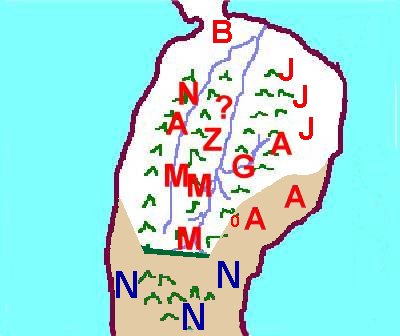 Now it is here that we had ought to make the point that the fears of Alma
would come to pass, that is the Zoramites or more precisely the land of
Antionum would fall away to the Lamanites. This is important to know and
understand, that when the Zoramites joined forces with the Lamanites, they
did not leave their land, but instead the land of Antionum became annexed
by the land of the Lamanites, the land of Nephi. And this in effect changed
the southeastern border of the national land of Zarahemla in relationship to
the national land of Nephi. The land of Nephi would from that time on include
the land of Antionum and the nation and land of Zarahemla would not. The
remaining Zoramite people of the land of Antionum had joined with the Lamanites
lot, stock and barrel, the whole of the land of Antionum included and no longer
would the border between the land of Zarahemla and the land of Nephi run in
a straight line of wilderness between the two nation from sea east to sea
west. The most southern border of Zarahemla upon the southwest would remain
the same, that being about the land of Manti and to the sea west from thence
in a striaght line. But upon the southeastern quarter, that southern border
had become deminished by the loss of the entire land of Antionum. A confirming
feature of the land would confirm this. The hill Onidah
upon which Alma spoke to the poor of the Zoramites in 74 B.C. (Alma 32:4) had
become by 72 B.C. that same hill Onidah as the place
of arms (Alma 47:5) to which the Lamanites who favored the deceased Lamanite
king did flee to in anticipation that
Amalickiah would come to destroy them as they would not at that juncture be
subjected to go against the Nephites, having been placed under oath by
Captain Moroni whom they well feared (74-73 B.C.; Alma 44:14-15 & Alma44:19-20).
Now it is here that we had ought to make the point that the fears of Alma
would come to pass, that is the Zoramites or more precisely the land of
Antionum would fall away to the Lamanites. This is important to know and
understand, that when the Zoramites joined forces with the Lamanites, they
did not leave their land, but instead the land of Antionum became annexed
by the land of the Lamanites, the land of Nephi. And this in effect changed
the southeastern border of the national land of Zarahemla in relationship to
the national land of Nephi. The land of Nephi would from that time on include
the land of Antionum and the nation and land of Zarahemla would not. The
remaining Zoramite people of the land of Antionum had joined with the Lamanites
lot, stock and barrel, the whole of the land of Antionum included and no longer
would the border between the land of Zarahemla and the land of Nephi run in
a straight line of wilderness between the two nation from sea east to sea
west. The most southern border of Zarahemla upon the southwest would remain
the same, that being about the land of Manti and to the sea west from thence
in a striaght line. But upon the southeastern quarter, that southern border
had become deminished by the loss of the entire land of Antionum. A confirming
feature of the land would confirm this. The hill Onidah
upon which Alma spoke to the poor of the Zoramites in 74 B.C. (Alma 32:4) had
become by 72 B.C. that same hill Onidah as the place
of arms (Alma 47:5) to which the Lamanites who favored the deceased Lamanite
king did flee to in anticipation that
Amalickiah would come to destroy them as they would not at that juncture be
subjected to go against the Nephites, having been placed under oath by
Captain Moroni whom they well feared (74-73 B.C.; Alma 44:14-15 & Alma44:19-20).
[Back to Page 1]
[Back to Previous Phase 6]
[Forward to Next Phase 8]
 It is difficult to pin point just when the land of Antionum was first
inhabited. But it would seem to have been at first a gradual evolution which
perhaps began during the times of dissentions and divisions amongst the
people which seem to have began with Nehor (91-88 BC) and his presentations
of the concept of priestcraft taken from the courts of wicked King Noah,
thus there is this other dissenting group to consider, the people of Ammonihah
in the northwest and the people of Antionum or the Zoramites of the southeast.
Though each group located in their different regions for their own reasons,
the primary reason stated for the Zoramites removing themselves out to the
eastcoast, bordering the lands of the Lamanites on the south, is this very
reason, that they were dissenters from the Nephites. As such, Alma
was fearful that since they had broken with the Nephite mainstream, they
might next decide to join with the Lamanites against the Nephites. (Alma
30:59 & 31:1-4) Alma's corrective or preventative measure was to attempt to
convert them back to Christ and the Nephite true religion.
It is difficult to pin point just when the land of Antionum was first
inhabited. But it would seem to have been at first a gradual evolution which
perhaps began during the times of dissentions and divisions amongst the
people which seem to have began with Nehor (91-88 BC) and his presentations
of the concept of priestcraft taken from the courts of wicked King Noah,
thus there is this other dissenting group to consider, the people of Ammonihah
in the northwest and the people of Antionum or the Zoramites of the southeast.
Though each group located in their different regions for their own reasons,
the primary reason stated for the Zoramites removing themselves out to the
eastcoast, bordering the lands of the Lamanites on the south, is this very
reason, that they were dissenters from the Nephites. As such, Alma
was fearful that since they had broken with the Nephite mainstream, they
might next decide to join with the Lamanites against the Nephites. (Alma
30:59 & 31:1-4) Alma's corrective or preventative measure was to attempt to
convert them back to Christ and the Nephite true religion.
 Now it is considered that land of Antionum and thus that of the 'Zoramites'
had been established before the sons of Mosiah II returned from their
Lamanite mission with the 'Anti-Nephi-Lehies', those converted Lamanites
associated with King Lamoni, who would be located in the land north of
Antionum, that is the land of Jershon, to live under the protection of the
Nephites, the Nephite armies placed between Jershon and the land of Nephi to
the south. And thus the land of Antionum would have been seen as just such
a buffer zone betwix the converted Lamanites, the Anti-Nephi-Lehies, and the
hostile Lamanites in the land of Nephi.
Now it is considered that land of Antionum and thus that of the 'Zoramites'
had been established before the sons of Mosiah II returned from their
Lamanite mission with the 'Anti-Nephi-Lehies', those converted Lamanites
associated with King Lamoni, who would be located in the land north of
Antionum, that is the land of Jershon, to live under the protection of the
Nephites, the Nephite armies placed between Jershon and the land of Nephi to
the south. And thus the land of Antionum would have been seen as just such
a buffer zone betwix the converted Lamanites, the Anti-Nephi-Lehies, and the
hostile Lamanites in the land of Nephi.
 Now we seem to be able to associate the establishment of the settlement of
the land of Antionum to the single life time of either Zoram their leader
and/or the single lifetimes of the poor among the Zoramites who had so built
the chapels of worship of the Zoramites. It may or may not have been Zoram
who led them to the land of Antionum but he 'was' currently leading the
hearts of the people to bow down to dumb idols at that juncture when
Alma's missionary mission was to come into the land of Antionum (Alma 31:1).
Now the Lamanite King over all the land of Nephi, the father of King Lamoni,
had sent a proclamaion throughout the land of Nephi in support of the Nephite
missionaries having access to teach the gospel in the land. And it is at this
point that Mormon the compiler and abridge of the Nephite record does defined
and set out a verbal map of the national land of Zarahemla and that of the
national land of Nephi. He records that a narrow strip of land divded the two
nations from the east sea to the west sea with such idle wandering Lamanites
who were hunters and gatherers merging in along the shore line upon the east
and west sea coast of the national lands of Zarahemla which the provided map
at the right illustrates.
Now we seem to be able to associate the establishment of the settlement of
the land of Antionum to the single life time of either Zoram their leader
and/or the single lifetimes of the poor among the Zoramites who had so built
the chapels of worship of the Zoramites. It may or may not have been Zoram
who led them to the land of Antionum but he 'was' currently leading the
hearts of the people to bow down to dumb idols at that juncture when
Alma's missionary mission was to come into the land of Antionum (Alma 31:1).
Now the Lamanite King over all the land of Nephi, the father of King Lamoni,
had sent a proclamaion throughout the land of Nephi in support of the Nephite
missionaries having access to teach the gospel in the land. And it is at this
point that Mormon the compiler and abridge of the Nephite record does defined
and set out a verbal map of the national land of Zarahemla and that of the
national land of Nephi. He records that a narrow strip of land divded the two
nations from the east sea to the west sea with such idle wandering Lamanites
who were hunters and gatherers merging in along the shore line upon the east
and west sea coast of the national lands of Zarahemla which the provided map
at the right illustrates.
 Now it is here that we had ought to make the point that the fears of Alma
would come to pass, that is the Zoramites or more precisely the land of
Antionum would fall away to the Lamanites. This is important to know and
understand, that when the Zoramites joined forces with the Lamanites, they
did not leave their land, but instead the land of Antionum became annexed
by the land of the Lamanites, the land of Nephi. And this in effect changed
the southeastern border of the national land of Zarahemla in relationship to
the national land of Nephi. The land of Nephi would from that time on include
the land of Antionum and the nation and land of Zarahemla would not. The
remaining Zoramite people of the land of Antionum had joined with the Lamanites
lot, stock and barrel, the whole of the land of Antionum included and no longer
would the border between the land of Zarahemla and the land of Nephi run in
a straight line of wilderness between the two nation from sea east to sea
west. The most southern border of Zarahemla upon the southwest would remain
the same, that being about the land of Manti and to the sea west from thence
in a striaght line. But upon the southeastern quarter, that southern border
had become deminished by the loss of the entire land of Antionum. A confirming
feature of the land would confirm this. The hill Onidah
upon which Alma spoke to the poor of the Zoramites in 74 B.C. (Alma 32:4) had
become by 72 B.C. that same hill Onidah as the place
of arms (Alma 47:5) to which the Lamanites who favored the deceased Lamanite
king did flee to in anticipation that
Amalickiah would come to destroy them as they would not at that juncture be
subjected to go against the Nephites, having been placed under oath by
Captain Moroni whom they well feared (74-73 B.C.; Alma 44:14-15 & Alma44:19-20).
Now it is here that we had ought to make the point that the fears of Alma
would come to pass, that is the Zoramites or more precisely the land of
Antionum would fall away to the Lamanites. This is important to know and
understand, that when the Zoramites joined forces with the Lamanites, they
did not leave their land, but instead the land of Antionum became annexed
by the land of the Lamanites, the land of Nephi. And this in effect changed
the southeastern border of the national land of Zarahemla in relationship to
the national land of Nephi. The land of Nephi would from that time on include
the land of Antionum and the nation and land of Zarahemla would not. The
remaining Zoramite people of the land of Antionum had joined with the Lamanites
lot, stock and barrel, the whole of the land of Antionum included and no longer
would the border between the land of Zarahemla and the land of Nephi run in
a straight line of wilderness between the two nation from sea east to sea
west. The most southern border of Zarahemla upon the southwest would remain
the same, that being about the land of Manti and to the sea west from thence
in a striaght line. But upon the southeastern quarter, that southern border
had become deminished by the loss of the entire land of Antionum. A confirming
feature of the land would confirm this. The hill Onidah
upon which Alma spoke to the poor of the Zoramites in 74 B.C. (Alma 32:4) had
become by 72 B.C. that same hill Onidah as the place
of arms (Alma 47:5) to which the Lamanites who favored the deceased Lamanite
king did flee to in anticipation that
Amalickiah would come to destroy them as they would not at that juncture be
subjected to go against the Nephites, having been placed under oath by
Captain Moroni whom they well feared (74-73 B.C.; Alma 44:14-15 & Alma44:19-20).